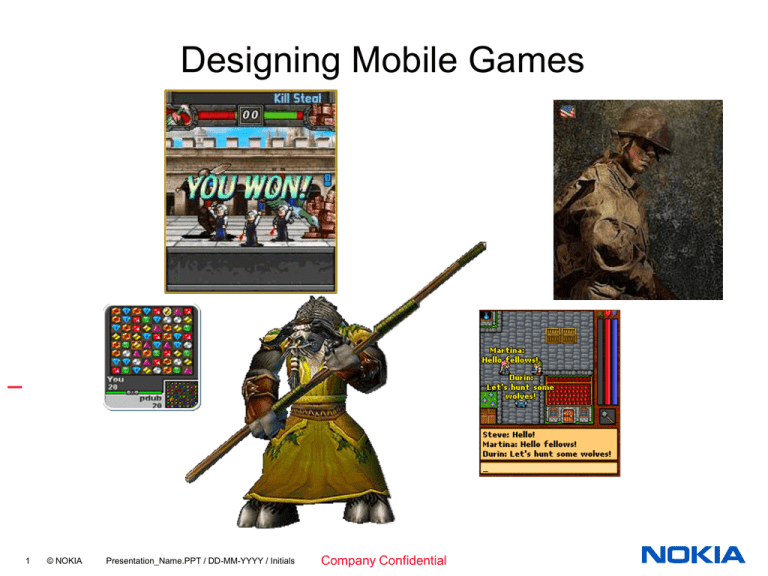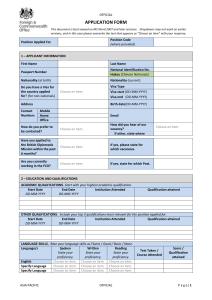the basics of mobile game design
advertisement

Designing Mobile Games 1 © NOKIA Presentation_Name.PPT / DD-MM-YYYY / Initials Company Confidential Speaker Introduction • Name: Greg Costikyan • Organization: NRC/Game House • Location: New York • How am I involved in (mobile) gaming: 3 decades as a game designer (30+ titles published), co-founder of one of US’s first mobile game developers, used to edit game section of Forum Nokia website, now work as a games resarcher for NRC. 2 © NOKIA Presentation_Name.PPT / DD-MM-YYYY / Initials Company Confidential What Does the Player Do? • Game design is not about story or character. • Game Design is about action. • Not necessarily fast action, but the player takes actions to affect the game state. • What does the player do? • Media assets are the “nouns” of the game—allowable actions are the “verbs” • UI allows you to trigger the verbs. • Each verb mapped to a UI feature. • In a mobile game, ideally 1 key = 1 verb • Possibly to net menus, etc., but preferable to keep actions mapped to individual key presses • Write down your list of verbs. • Possible to build a good game with limited verbs: Doom has only 8 (left, right, ahead, back, jump, shoot, switch weapons, pick up) • Can you see how your list could produce an interesting game? 3 © NOKIA Presentation_Name.PPT / DD-MM-YYYY / Initials Company Confidential Verbs (con’t) • Will a single key-press suffice? • E.g., two used in golf games (direction and power). • Avoid multiple simultaneous key-presses when possible, as many J2ME implementations don’t permit this. • If feasible, avoid mapping multiple actions to a single key, or different keys to the same action, to avoid player confusion. • A single key to mean “act” or “select” can work, IF the meaning is always clear in context. • Game design has two main components: UI specification and gameplay algorithm specifications. The two must dovetail neatly, and it is worth thinking about clean UI design from the start. 4 © NOKIA Presentation_Name.PPT / DD-MM-YYYY / Initials Company Confidential Struggle & Challenge • A game should be a struggle. • If too easy, it is boring. • If too hard, it is frustrating. • Have to find a happy medium. • Players enjoy overcoming challenges. • Difficulty settings help. • Dynamic difficulty adjustment can be used, but carefully. • Three basic kinds of challenges: • Physical • Mental • Opponents (AI or players) 5 © NOKIA Presentation_Name.PPT / DD-MM-YYYY / Initials Company Confidential Types of Challenges • Physical: Depends on timing and mastery of the interface. • Mental: • Resource trade-offs • Tricky placement of game objects • Interacting systems whose behavior is hard to solve • Combining game objects • Even if your game is not puzzle-based, think about how to use the verbs of the game to produce interesting puzzles • Opponents • For multiplayer, this is provided by the other players • In single-player, this is provided by AI. • Even simple AI can make opposition more interesting to the player • Example: Space Invaders • After defining verbs, defining the sorts of challenges your players will face comes next. 6 © NOKIA Presentation_Name.PPT / DD-MM-YYYY / Initials Company Confidential Categories of Pleasure • Marc LeBlanc’s taxonomy of game aesthetics • Always useful to think about what aesthetic pleasures players will draw from the game • Sensation: Graphics, sounds, tactile feeling, etc. • Fantasy: Consistent and appealing background/world/story. • Can be simple: “An Italian plumber must rescue his girlfriend from a giant ape.” • Narrative: Not necessarily “story,” but narrative arc: Sense of heightening tension and release. • Challenge. • Fellowship: Important particularly for multiplayer, but even with soloplay games, players enjoy talking about their experiences. • Discovery: Exploration, new things (with each level?) • “Masochism:” Submitting yourself to the structure of the game. • Does your design provide each/some of these? 7 © NOKIA Presentation_Name.PPT / DD-MM-YYYY / Initials Company Confidential Constraints • Constraints do not limit creativity; they spur it. • The sonnet. • Application size. • If targeting older Series 40 phones <=64k • Application memory space • When running, application consumes more than the app size itself—graphic buffers, objects created at runtime, etc. • For older Series 40 phones <200k. • Screen size & format: • Characters should be ~10-15% of height and width of screen • If a “HUD” is used, it must be simple—ideally <6 pieces of information. • Portrait rather than landscape format. • Processing power (complicated simulations a problem) 8 © NOKIA Presentation_Name.PPT / DD-MM-YYYY / Initials Company Confidential Constraints (con’t) • Mobile Device UI • Can generally rely an an ITU-T keypad, two soft keys, D-pad • No pointing device • Variable keypads • The social space of mobile devices • Handle interruptions gracefully • Go easy on the sound (and gameplay MUST NOT depend on it) • Keep the backlight on • High color contrast for readability in direct sunlight 9 © NOKIA Presentation_Name.PPT / DD-MM-YYYY / Initials Company Confidential How Multiplayer Games Differ • Players provide the challenge • Provide ways to help and hinder each other • Replayability vital. • Handle player drops gracefully • “Civil Disorder” • AI take-over • Replacement player • Or design so that the loss of a player is unimportant • Player Matching • “Quick game.” • Challenges • “Reserving” a game for friends (buddy lists?) • Use of rankings to match players of equivalent skill • Short play sessions • Ideally <=15 minutes 10 © NOKIA Presentation_Name.PPT / DD-MM-YYYY / Initials Company Confidential Multiplayer Differences (con’t) • “Balance” no longer = right difficulty level • Instead = all players have equal chance of winning • However, asymmetric games can be balanced • Diplomatic games are self-balancing • Physical: Depends on timing and mastery of the interface. 11 © NOKIA Presentation_Name.PPT / DD-MM-YYYY / Initials Company Confidential Game and Network Issues • Server-driven games • Ongoing cost for game provider • Secure data storage • Makes cheating harder • Bandwidth-to-user not normally a constraint • Peer-to-peer • Cheaper for game provider • Cheating easier • With large numbers of players, bandwidth becomes a bottleneck • Particularly for Bluetooth, which is always hub-spoke configuration • Not feasible with legacy phones (requires IP address, SIP, or Bluetooth) • Player matching/discovery becomes a problem 12 © NOKIA Presentation_Name.PPT / DD-MM-YYYY / Initials Company Confidential Dealing with Latency • Always a problem with networks • On wired Internet, 100-200ms latency rules out street fighters • On 2G networks, ~1 second latency • If HTTP must be used, ~5 second latency • NRC tests show that UTMS can produce >100ms latency • ---But in lab, actual network deployments may be slower.. • And generically, “3G” doesn’t solve all problems—EV-DO in deployment ~500ms latency • In general, unless targetting UTMS, must always work around latency issues • Approaches: • Turn-Based games (round robin or simultaneous movement) • Act-whenever • Slow update games • Shared solitaire games • Mask latency with game fantasy • Untie game outcomes from specific play configuration 13 © NOKIA Presentation_Name.PPT / DD-MM-YYYY / Initials Company Confidential Designing for Community • Shared high-scores, tournaments, etc. • But many pitfalls: • Avoid incentives for player drops • Don’t encourage newbie-bashing • No “perfect” scores • Permanent high scores can be a deterrent • Chat • Keypad text entry a problem—taunts? • SMS for persistent/long term games • Pathway to Glory use of VoIP • Friend Finding • Buddy lists • Phone number/User ID query • SMS challenges • Diplomacy • Web presence 14 © NOKIA Presentation_Name.PPT / DD-MM-YYYY / Initials Company Confidential The Metagame • Richard Garfield & Magic: The Gathering • Anything surrounding the game that increases player interest • Tournaments/seasons • Trading • Offline activities • Stable strategies 15 © NOKIA Presentation_Name.PPT / DD-MM-YYYY / Initials Company Confidential No Single Methodology • Tried to provide a coherent framework here • This is an art, not an engineering discipline • Kipling: “There are four and twenty ways/of writing tribal lays/And every single one of them is right.” • But in general, if you think about “what the player does,” what pleasures players draw from the game, and what techical and business constraints apply, you’ll start from a solid base. 16 © NOKIA Presentation_Name.PPT / DD-MM-YYYY / Initials Company Confidential









